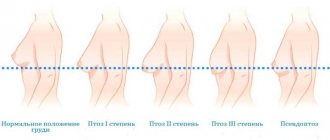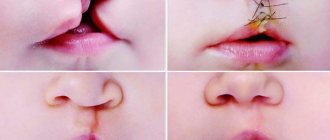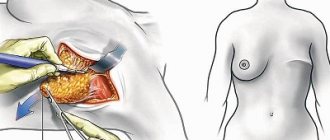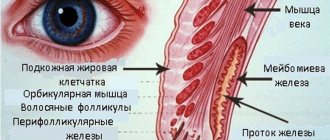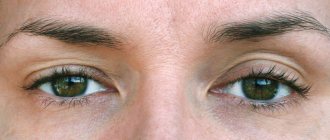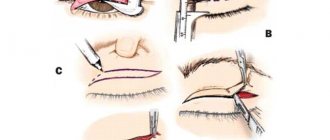Photos before and after Reviews Videos Rehabilitation Prices Analyzes Questions and Answers
We will not reveal any secret if we say that breasts are a unique symbol of female beauty. It's always been like this. But, unfortunately, nothing is permanent in the world; female beauty fades over the years. The breast can be compared to a flower bud that has just opened. It is beautiful and fresh, it captivates the eye, catches glances full of admiration, but time passes and the flower changes...
The same is true for women’s breasts: in youth they are firm and high, but with age they change . For some, after childbirth, it becomes smaller, for others, it droops, for others, it suffers from the fact that the breasts are too large, but, either under their own weight, or over time, they sag a lot and look ugly. Grieving about the past or trying to regain youth with the help of pills or creams is pointless. But this does not mean at all that a woman should give up on herself and her beauty.
Modern plastic surgery is ready to offer every woman a more than effective way to turn back time. This is mammoplasty . The first thing an experienced plastic surgeon should do before choosing the type of operation is to determine the condition of the patient’s mammary glands. What kind of skin does she have, glandular tissue, what degree of breast sagging (degree of ptosis).
Everything is determined individually. In no case should you approach breast surgery as something serial, because what is ideal for one patient may not be suitable and may even harm another. This applies even to the usual and uncomplicated breast augmentation. And if a woman wants to simultaneously reduce and tighten her breasts, she needs to carefully weigh everything, because it is quite possible that one breast lift will be enough.
Mammoplasty: rehabilitation by day
The first thing you need to understand: although plastic surgery refers to aesthetic medicine, it is nevertheless surgery. Therefore, mammoplasty should be treated not only as an operation that helps make the breasts beautiful and the figure more harmonious, but also as a serious intervention. Accordingly, the day-to-day recovery after mammoplasty will be similar to recovery after a “traditional” surgical operation.
1 day.
Upon completion of the operation, the patient is transferred to the recovery room. There her condition is monitored by an anesthesiologist. After 1–1.5 hours, the patient is transferred to a regular ward, where she can rest after the operation, but will be under the supervision of medical personnel. At the same time, drug treatment begins. It includes painkillers that help eliminate discomfort in the operated area. Antibacterial drugs can also be used, the purpose of which is to prevent possible complications. Even in the operating room, after sutures are applied and processed, the patient is put on compression garments pre-selected to size. It provides reliable fixation of the breast and prevents its displacement. You need to wear it constantly for a month, even during sleep, taking it off only for hygiene procedures.
1–4 days.
Hospital stay is usually limited to one day. Before discharge, the patient is given a memo that contains all the recommendations for the correct completion of the recovery period. If this is necessary, the doctor conducts an additional consultation. For 3-4 days after mammoplasty, any physical activity should be avoided - it is advisable to spend this time observing maximum rest. More or less pronounced pain and discomfort are felt in the mammary glands, which are natural for any surgical intervention. But these symptoms are alleviated and even completely eliminated with the help of medications prescribed by a doctor. In addition, there may be a slight increase in body temperature, usually between 37.0–37.5 °C.
3–4 days.
During this period, swelling of the breast tissue becomes most noticeable. This is a natural reaction of the body and should not cause concern. In addition, you should not be afraid of the “strange” appearance of the breasts - the shape and size of the mammary glands can be changed by swelling to a greater or lesser extent, but in this period it is too early to draw conclusions about the results of the operation. Swelling may slightly increase discomfort as it makes it difficult to move your arms. This symptom may persist for several weeks, but gradually its severity will decrease. It is important to know that swelling can intensify during sports, at high ambient temperatures, etc. Therefore, it is necessary to carefully follow recommendations for limiting physical activity, avoid visiting the sauna, avoid being in direct sunlight, etc.
5–6 days.
At this stage, the pain hardly bothers you or bothers you very little, which does not require taking painkillers. During this period, you can gradually return to your normal life. But the key word is still “gradually.” For another 4-5 weeks, you need to exclude any loads that involve the muscles of the upper shoulder girdle and chest. Heavy lifting, active sports and similar types of physical activity should not be allowed. And the “sleeping on your back” rule still applies - it will be relevant for 2-3 weeks after the operation.
1 Week.
Seven days after mammoplasty, the time for the first visit to the doctor. There will be four in total, but the first visit is the most important and should not be missed under any circumstances. During the consultation, the surgeon will assess the degree of healing of the sutures, the position of the endoprostheses and other criteria by which a conclusion can be made about the quality of tissue restoration. A conversation is also held with the patient, during which the doctor can adjust or discontinue medication treatment, as well as give additional recommendations necessary in a particular case.
2 weeks.
At this stage, the patient has already become accustomed to the “new” breast, the pain has disappeared, and compliance with the restrictions recommended during the recovery period no longer causes difficulties. Fitness classes, visiting the pool, solarium and sauna are still prohibited, but to maintain physical fitness you can take walks without any restrictions.
1 month.
The next examination by a surgeon is carried out in order to both assess the progress of recovery and adjust recommendations. So, if the patient has followed all the rules for undergoing rehabilitation and healing is progressing successfully, the doctor may allow you to remove the compression garment while sleeping or remove other restrictions. But it is important to understand: this depends on the characteristics of the mammoplasty performed - for example, with a significant breast enlargement, restrictions may last longer than with a breast reduction or breast lift.
2 months.
By this time, it is already possible to draw the first conclusions about the results of the operation. The swelling completely disappears or decreases to almost imperceptible, the discomfort is no longer a concern, and at the next visit to the surgeon the patient can receive permission to play sports. Of course, subject to moderation and gradualism. From this period onwards, life almost completely returns to normal, with very few exceptions. It is still necessary to avoid stress on the upper shoulder girdle and chest muscles, thermal procedures (visiting a bathhouse, sauna, taking a hot bath, etc.) and avoid mechanical impact on the tissue of the mammary glands - massage, rubbing the chest with a washcloth and similar actions will still be prohibited a few months.
Breast lift
Breast lift surgery involves removing excess skin and tightening breast tissue without affecting the mammary gland itself . The breasts become higher and look younger due to the restoration of elasticity; in addition, if necessary, asymmetry is eliminated.
The simplest version of a breast lift is based on one of the golden rules of all plastic surgeons - fewer marks on the skin. When using it, the postoperative scar is almost invisible, as it passes around the areola, periareolar mastopexy .
Another lift option is more complex. If the plastic surgeon uses it, then the scar will not only be around the areola, but will also extend from the bottom of the areola to the inframammary fold.
Both breast lift options are used strictly according to indications, for example, when a woman, in addition to the lift, also wants to reduce the areola itself, or there is a problem of excess skin despite the fact that there is no breast sagging itself.
But the most common option for a lift is to make an additional incision in the inframammary fold itself.
We must also take into account the fact that breast lift surgery does not in any way injure the mammary glands themselves, so after it the woman has the opportunity to breastfeed her child .
What to pay attention to
Breast restoration after mammoplasty largely depends on the individual characteristics of the patient’s body, metabolic rate, general health and other factors. Therefore, the periods listed above can shift down or up, and the rehabilitation will proceed normally. But in some cases, you should contact your doctor without waiting for your scheduled consultation date.
Contact your surgeon if you experience any of the following symptoms:
- increased body temperature, which persists 7–10 days after surgery;
- discharge from sutures;
- significant changes in the scars (severe redness, their bulge, etc.);
- marked deterioration in health, lack of recovery 2–3 weeks after surgery.
In most cases, such symptoms indicate an incorrect recovery period or are associated with the individual characteristics of the situation. But as a precaution, you should contact your doctor and get specialist advice.
How to reduce breasts for a teenager. How to reduce breast size at home
A sudden increase in breast size due to pregnancy or weight gain can make you feel…uncomfortable. What should a girl do if large breasts become a problem? How to reduce breasts at home? Is it possible to forget about size 4 and go to 1?
If you want to slightly reduce your breasts without surgery and make them firmer, we are ready to help you! Here are some useful tips on how to make your breasts smaller.
The size of your breasts is determined by a number of specific factors:
- genes play a major role in determining breast size and shape by influencing hormones that affect breast tissue.
- Weight: Most of a woman's breasts are made up of fatty tissue. This is why if you lose or gain weight, your breast size will also change.
- Age: As you age, the ligaments that support the shape of your breasts can become stretched, leading to sagging.
- Breastfeeding: Due to hormonal changes, breast enlargement is also observed during lactation. Therefore, if you want to know how to reduce mammary glands at home, read on.
Now that you know what determines the shape and size of your breasts, let's look at several ways to reduce breasts without surgery.
Best Ways to Reduce Breast Size Naturally
Fenugreek
You will need:
- 3 tbsp. fenugreek seeds
- water
- Soak fenugreek seeds in water overnight.
- In the morning, add a few drops of water to the seeds to make a thick consistency.
- Apply the paste to your chest.
- Leave until completely dry, then rinse.
Perform the procedure 3-4 times a week.
How it works?
Fenugreek seeds can help firm and reduce breast volume. In addition, they prevent sagging and loss of shape.
Flax seeds
You will need:
- 1 tbsp. ground flaxseed
- 1 glass of warm water
- Mix the ground flax seeds well in the water.
- Drink the resulting drink.
- You can also add ground seeds to any dish or juice.
Perform the procedure once a day.
How it works?
Flax seeds reduce the level of estrogen, the hormone responsible for the enlargement of breast cells. Reducing its size will help reduce breast size.
Ginger
You will need:
- 1 tsp. ground ginger
— 1 glass of water
How it works?
This method will be especially effective if you want to reduce your breasts at home after pregnancy or lactation. During breastfeeding, breast enlargement is promoted by its swelling and accumulation of fatty tissue. Melia and turmeric help to cope with these problems.
Garcinia cambogia
You will need:
— 300-500 mg of dietary supplement with Garcinia Cambogia extract
Take the supplement 3 times daily
How it works?
Garcinia Cambogia has excellent fat burning properties. Regular consumption of these supplements will help speed up your metabolism and make weight loss easier.
How much do breasts shrink when losing weight? Reasons for the decrease
Why do your breasts get smaller when you lose weight? Most ladies struggling with extra pounds encounter a similar problem. According to physiology, breasts melt during weight loss for several reasons.
- The fat layer is thinning. The mammary glands are surrounded by a lipid layer, which is necessary to protect such an important organ, which during lactation will produce milk for feeding the baby. In addition, a layer of fat gives a woman’s bust a pleasant fullness and roundness. The fat layer protects the glands from traumatic factors and temperature changes. This layer contains a supply of nutrition if the mother lacks the necessary substances for full breastfeeding. How much fat there is in the bust depends only on genetics. But in the process of fat burning, the breasts always lose weight, although sometimes not noticeably.
- Weakening of the muscle corset, decreased skin tone. It is impossible to pump up a bust like a bodybuilder, because there are no muscle tissues in its tissues. But there are plenty of them around the gland. They form a kind of supporting corset, like a bra made of muscles. If a woman has lost weight and her breasts have become smaller, it means that due attention has not been paid to training the muscles that support the bust, which have weakened greatly and led to sagging. Therefore, when losing weight, you need to take care of both the muscles and the condition of the skin, which does not have time to get used to the new position and sags. To avoid such unpleasant surprises, it is recommended to perform special gymnastics.
- Another reason for breast reduction during weight loss is considered to be relaxation of Cooper's ligaments. These are thin connective tissue structures that maintain the elasticity and pleasant shape of such an outstanding organ. Incorrect underwear or sudden weight loss, neglect of wearing a bra and age-related changes inevitably lead to stretching of the ligamentous structures and sagging breasts.
Exercises to reduce breasts for a girl
We offer a simple set of exercises that will help you reduce your breasts at home. For training you will need light dumbbells, a jump rope and a shoulder expander. Do 3-4 workouts per week.
Warming up the body
Jump rope, occasionally speeding up, for 5-7 minutes.
Push-ups (3x12)
- Take a lying position and lower your knees to the floor.
- Bend your legs, let your shins hang.
- Place your palms slightly wider than your shoulder joints.
- Inhale and slowly lower your chest towards the floor.
- As you exhale, straighten your arms.
When performing, make sure that your hips and body remain in line.
“Butterfly” standing (3x12)
- Stand up straight and grab the handles of the expander.
- Place the shock absorber on your back and straighten your arms to the sides.
- Exhale and slowly bring your arms together in front of you.
- Hold for 1-2 seconds, then, inhaling, smoothly move your limbs back to their original position.
Dumbbell press (3x12)
- Build an improvised gymnastics bench by placing three stools in a row and lie on them with your back.
- Press your feet to the floor.
- Take dumbbells and lift them over your pecs.
- As you inhale, slowly lower your elbows below your body line.
- Hold for 1-2 seconds, then, exhaling, gently press the dumbbells to the starting position above your chest.
Pullover (3x12)
- Lie with your back on a “bench” of chairs so that your head is at the very edge, but not hanging down.
- Take the dumbbell with your hands by the ends and lift it above your forehead.
- Arch your back and straighten your chest, but do not lift your shoulder blades.
- Inhale and slowly lower the bar behind your head.
- At the bottom point, pause for 1-2 seconds, then, exhaling, return the dumbbell to the starting position.
Indications
The reasons for plastic surgery may be medical indications or the patient’s wishes:
- congenital anatomical and physiological features;
- asymmetry;
- excessive growth of the gland due to hormonal diseases;
- age-related changes (reduction in size and restoration of the contours of sagging breasts);
- correction of overstretched halos;
- chronic pain syndrome in the spine;
- reconstruction after childbirth or during rapid weight loss.
Quite often, girls resort to breast reduction when large breasts do not allow them to play sports professionally or limit the level of physical activity. In some cases, a lush bust is simply not liked by its owner, causing constant discomfort (irritation, dermatitis, or the banal inability to choose a wardrobe as desired).
In most cases, the reason for treatment is deformation of the mammary glands or pain caused by inadequate load on the spinal column.
Is there a connection between nutrition and breast firmness?
As a rule, for a woman, it is not so much the size of the bust that is important, but its shape. How to properly build your diet so that it is as beneficial as possible for the female body? Since ancient times, women have tried various diets that can affect their bust size.
Two components play an important role in the size and shape of the breast Adipose tissue is part of the mammary gland itself, and muscle tissue, that is, muscles, is the basis on which the bust itself is “attached” directly. If the muscles that support the mammary gland are developed and strong, even the smallest breasts will be high and firm. And adipose tissue will give the bust a rounded shape and the desired size.
To build muscle tissue, you must include protein foods in your diet, and to form adipose tissue, vegetable and animal fats and carbohydrates. Among fats, preference should be given to vegetable fats, as they are more beneficial for the female body. And among carbohydrates you need to choose so-called slow carbohydrates. An excellent source of slow carbohydrates is a variety of cereals.
Possible side effects
Medical surgeons perform reduction mammoplasty under conditions of absolute sterility, guided by official protocols. The number of postoperative complications is minimal (1-2%). However, unpleasant situations during the recovery period are often not related to the doctor’s skill: the anatomical and physiological characteristics of the patient and compliance with recommendations are of great importance.
- Increased body temperature. The symptom may be a sign of an inflammatory reaction or an individual immune response.
- Decreased breast skin sensitivity. Sometimes it appears in the first weeks after the procedure, then it stops on its own. Usually localized in the area of the nipple and areola.
- Tissue swelling. Accompanies any surgical intervention, “goes away” after normalization of blood circulation and lymph flow in the operated area.
- Soreness. The intensity of sensations varies - from minor discomfort to quite intense pain. This is directly related to the reactivity of the nervous system and the individual pain threshold.
If any of the above phenomena bother you, contact your doctor. He will conduct an examination and, if necessary, prescribe additional studies. Self-medication is strictly prohibited.
How is the operation performed?
The name of the manipulation comes from the Latin “reductio”, which translates as “reduction” or “reduction”. Thus, the essence of the operation is inherent in the definition itself.
The complexity of the procedure lies not only in the need to achieve the aesthetic appeal of the breast. The main task is to maintain adequate blood supply, innervation and lymph flow in the nipple-areolar area. Only doctors of the highest professional category can do this, which, without a doubt, includes Etalon plastic surgeons.
Removal of excess volumes is carried out in one or more sectors. The edges of the surgical field are sutured. Moreover, in the early recovery period, the breasts may have a somewhat unnatural shape (more rounded in the upper part), this is a variant of the norm. Within a few weeks, under the influence of gravity, the mammary glands will take on physiological shape.
If necessary, there is an excessive amount of subcutaneous fat, the operation is supplemented with liposuction. Also, in some cases, tissue tightening is recommended to eliminate the phenomena of gravitational ptosis. The final decision is made by the attending doctor after a preliminary examination.
Depending on the volume that is defined as “extra”, the reduction is made by 200-1000 grams (in each gland). With gigantomastia, which is an extreme degree of enlargement, even more.
At the final stage, tubes made of medical biopolymer are installed, through which the discharge from the postoperative wound will be freely removed. These are the so-called drainages. This will prevent the accumulation of blood, lymph and serous fluid and eliminate the risk of infection. The drainage tubes are removed after two to three days, the procedure is carried out using anesthetics, and is completely painless.
Sutures are applied in several ways (this depends on the initial size of the female breast):
- vertically down from the halos (with various options);
- around the nipple;
- down from the nipple with an additional horizontal one in the area of the inframammary fold.
Many patients express concern about the presence of stitches. In fact, there are no rough scars left at the site of mammoplasty. The marks are quite thin and do not spoil the appearance.
When resorting to a reduction operation, it is necessary to understand that interventions of such complexity cannot be carried out without a trace.
When should reduction mammoplasty not be performed?
Before deciding to have it performed, it is necessary to exclude all possible contraindications, since the reduction operation is quite complex:
- neoplasms;
- inflammatory processes (including infectious);
- some concomitant diseases (severe heart failure or diabetes, coagulopathies, etc.);
- local pathology in the area of the upcoming intervention;
- chronic diseases in the active stage.
It is not recommended to resort to a radical method until the age of 23-25. During this period, the formation of the body is not yet completed. Also, mammoplasty should not be performed during pregnancy or lactation.
